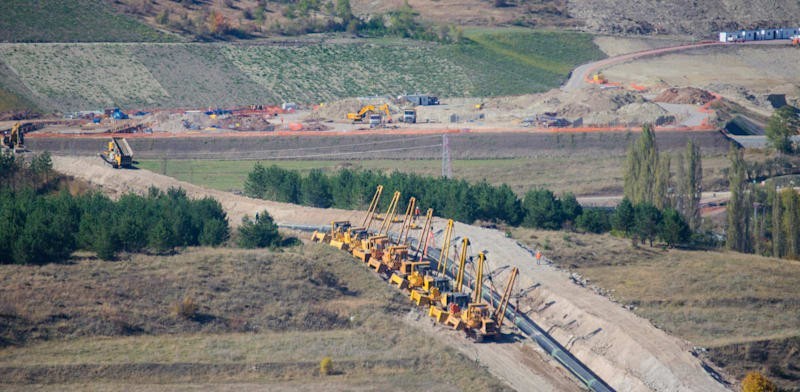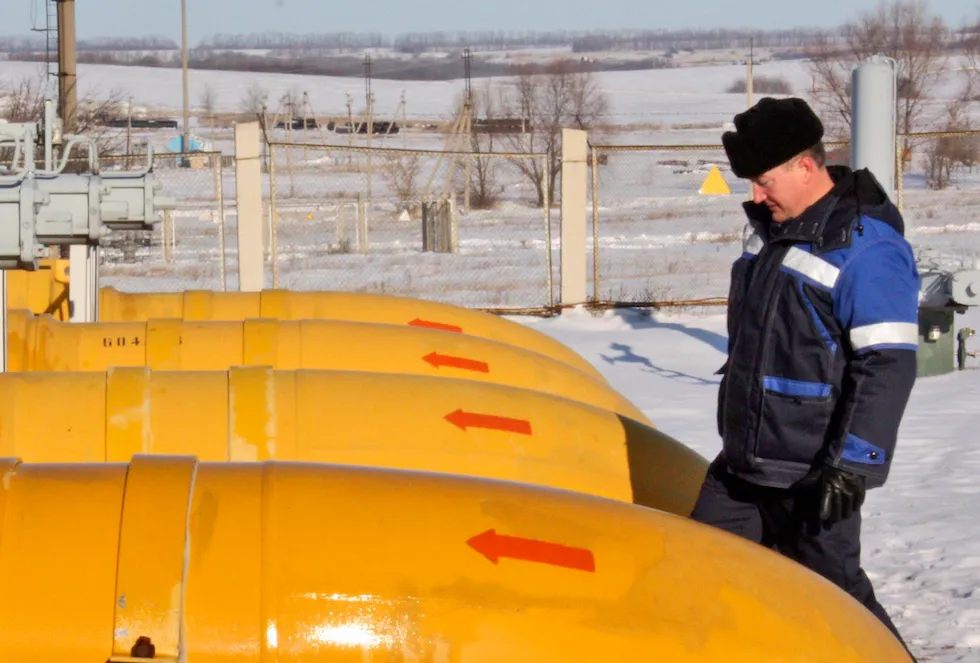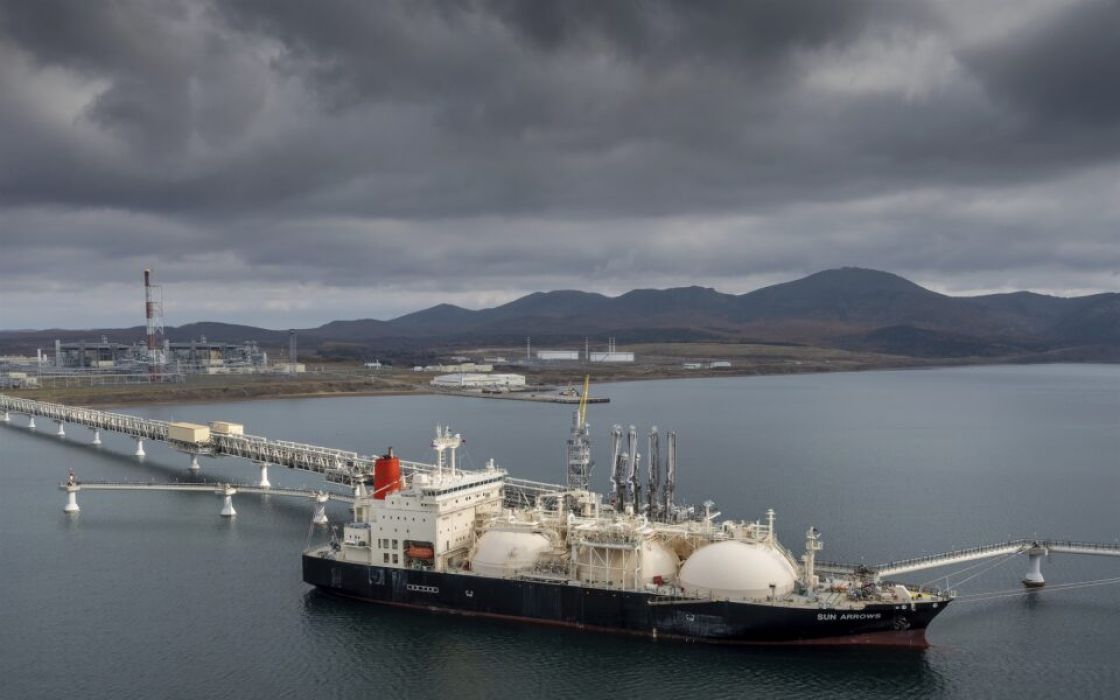- Articles
- Posted
Revisiting the So-Called “Arab” Gas Pipeline… What Does the Current Conflict Tell us about the Pipeline?
Major and pivotal conflicts of the kind that the world is experiencing today open the door to exploring future possibilities and trying to understand them, but they also provide important clarifications about issues from the recent past and older. There are many international, regional, and even domestic dossiers, the full dimensions of which were difficult to comprehend at the time they occurred, but with the outbreak of the current conflict they became clearer, and their general context, targets, and positioning became more understandable and comprehensible. Among these dossiers is that of the so-called “Arab” gas pipeline.
The Kassioun Research Unit, over around half a year, dedicated a set of studies and articles about this issue, since it first came up early last summer. However, this same issue, after having disappeared from the forefront in the last few months, is back again – with the eruption of the Ukrainian situation and with it the global situation – to become one of the main topics with which the media is dealing, especially Western and “Israeli” media. This is understandable at least due to its connection to the major energy crisis the world is experiencing, especially Europe.
The Article’s Structure
This article is divided into three main sections. In the first section, we will provide a very condensed summary of some of the main findings we had previously reached based on its studies regarding the “Arab” gas pipeline.
In the second section, we will look at some important articles and comments that appeared in Western and “Israeli” media over the past month on the topic.
Finally, in the third section, we will go back to where we started, that is, we will try to widen the angle from which we look at this pipeline, based on our previous findings and what the current global conflict has exposed and is exposing.

Part One: Summary of Previous Studies
Herein we will present some of the main relevant conclusions and details we previously highlighted in the Unit’s studies about the pipeline, with links to some of those studies. It should be noted that these conclusions are in no way a substitute for the detailed studies that have a great amount figures, calculations, statements, and references. However, they suffice for the purposes of this article.
- In the first article about the subject, we posed some questions based on the limited information available at the time. One of the main questions was related to the apparent US approval of the project, which would pass through Syria, thus effectively exempting the project from the Caesar Act. Most of the other questions revolved around the clear “Israeli” role in this project, and where that stands, particularly in light of using “Arab” in its name, as if to divert attention from the role of the Zionist entity therein. All of that led to the bigger question regarding the link with the normalization between some Arab countries and “Israel”, which had already started at that time.
- A few days later, another article looked more closely at the issue, mainly looking at the indications of the timing of proposing this project at the international, regional, and Syrian levels. At the international level, and relevant to today’s events, we concluded that the project’s international identity (despite the “Arab” in its name) is a Western one, and implicitly going against the “Belt and Road” and “Eurasian” projects. Regionally, with the project being marketed as a solution to Lebanon’s electricity problem but at best providing it with 5.5 additional hours of electricity per day, along with other factors, the main objective is likely political and specifically contributing to the push to expand the ongoing normalization with the Zionist entity. At the Syrian level, besides possibly using Syria as a conduit to transfer stolen Palestinian gas and possibly putting Syria in a position of being subjected to “Israeli” bullying, the project can also be looked at as another manifestation of undermining the efforts of the Astana track, this time using economic tools.
- Within studying the subject economically, we looked in one article at how Jordan produces its electricity, before exporting it to Lebanon or other countries. In this regard, we started with a historical overview tracing the relationship between Jordan and the Zionist entity since early last century, then later an energy cooperation clause in the Wadi Araba Treaty (1994), and finally a 2016 agreement to import natural gas from “Israel”. The latter agreement was signed by the same company that is supposed to supply Lebanon with electricity, through Syria. Interestingly, looking at the 2020 figures, Jordan’s electricity surplus could be used to provide 12 minutes of additional electricity in Lebanon per day. This begs the question again about the real objectives of this “Arab” project.
- We discussed in one article the latest with regards to Syria in light of the existing tracks and poles, and the latest developments at the time. In that context, we discussed, among other things, the large-scale American withdrawal and repositioning process, one of the manifestations of which is a move towards deepening the economic attrition in the region in general and Syria in particular. We indicated that projects such as the “Arab” gas pipeline fall within the category of moves in preparation for rearranging things in the region to support the change associated with the US’s presence regionally. We also noted that the project is among several indicators of activities of the “small group” to counter the Astana track in particular and more generally to keep the region’s subservience and dependence on the West, with the aim of hindering or delaying turning East, particularly economically.
- Along those lines, we focused in one article on exploring how the Arab governments are merely facades for the “Arab” gas pipeline, by looking at the actual roles of the governments of two of the countries involved: Jordan and Egypt. Looking at Egypt, we noted that to fulfill its own domestic needs, it has to buy gas from “foreign partners” (in a subsequent article (Arabic) a couple of months ago, we looked at some of the efforts by Egypt to boost its energy role in the region, and the clear link with the continued efforts to keep the “Arab” gas pipeline project alive and feasible; much of the efforts related to expanding cooperation with “Israel”). As for Jordan, the public power company is the only one that incurs losses, while the private ones are profitable, which means that the government would have to incur greater debt to export electricity, thus increasing the profits of the private and “foreign” companies (those partners are the ones that supply the energy for the power generation – that is, “Israel”).
- In an article in which we discussed the idea of “normalization with the regime”, we looked at the how US policies today are a continuation of what it had started since the 1950s as part of inheriting the “properties” of Britain mainly and France to some degree, and turn the region into a Western-affiliated frontline with the Soviet Union and China. In this context, we compared the “Arab” gas pipeline and similar types of initiatives with similar steps used starting in the 1950s in the confrontation with the East. This involves, in a great part, efforts to remove Syria from its historical alignment to make it economically and politically Western. Part of the objectives of similar processer, much like the Operation Alpha with regards to Egypt, is to drag Syria into “peace” with “Israel”.
- Continuing on with the same idea, a subsequent article looked specifically at the role of the World Bank in the project and the process as a whole, particularly in light of its role in the Aswan High Dam issue in the 1950s. Keeping in mind the objectives we believe are desired from the “Arab” gas pipeline, which are referenced in all the above, and drawing on comparisons with the role of the World Bank with regards to the Aswan High Dam, where it initially was set to fund it then withdrew due to pressure by the US, just like the World Bank has made initial indications of supporting the “Arab” gas pipeline. It seems like what must be done is for Syria to look for alternatives that are consistent with what Syrians want and what is best for Syria, which would be to turn East – specifically towards Russia and China. This is not just the economic level, but also politically, in order to achieve the full implementation of UNSC Resolution 2254, which would be through the Astana track + China.

Part Two: What are They Saying about the Pipeline Today?
With all the events taking place today, especially in Ukraine and the subsequent actions by the West headed by the US, including sanctions on Russia, talk about gas is again surfacing and at a much broader level, but not completely disconnected from our region. Nevertheless, the context in which discussion of the gas issue is taking place today is from an angle of deficiency and disorder, which are threatening the world market, especially the European one, under US bullying.
- On March 15, US news outlet, The Hill, published an article urging that the US “help ensure that eastern Mediterranean natural gas makes it to Europe’s shores” in order “to subvert Russia”. While the article saw that it was reasonable to withdraw support for the EastMed Pipeline in late January, it noted that “considering Russia’s war in Ukraine and its downstream effects, Biden must show flexibility and adapt his natural gas policy”. The article goes on to say that “Linking eastern Mediterranean gas to Europe could have a profound psychological effect on Russian President Vladimir Putin. It would undermine Russia as a player in the region’s energy market and militarily”. Stated more clearly, the article says: “As the U.S. recedes from the region, it must leave in place a regional security architecture that provides stability, respect for rule-of-law, and deterrence to nefarious actors such as Putin. Sponsoring energy links to Europe would signal to Putin that the U.S. (and indirectly NATO) remains committed to its allies in the eastern Mediterranean, who will certainly enhance military cooperation as the stakes increase”.
- An April 5th article on Greek news website, Kathimerini, looked at the energy crisis that could result from cutting off Russian gas, and how different European countries can find “a substitute for the approximately 170 billion cubic meters of Russian natural gas”, which is “impossible before 2024-25” but feasible for the EU by the end of the current decade “under two strict conditions: a) that it increases domestic natural gas production, and b) that it maximizes the diversification of natural gas sources and supply routes from geopolitically neutral areas”. The article explores different options, one of which is the “full utilization of Egypt’s LGN terminals for exports from Israel and Cyprus”.
- An article published in The Jerusalem Post on April 7 cited “Israeli” Energy Minister, Karin Elharrar, saying: “The European energy market is facing a substantial shortage following the Russia crisis… Israel sees an opportunity and will take full advantage of it”, which could be “as soon as this summer”. According to the article, “Elharrar and EU Commissioner for Energy Kadri Simson established a working group on energy, which Egypt will be joining as well. The working plan, based on an agreement between Elharrar and her Egyptian counterpart that has yet to be finalized, is for Israeli natural gas to go through Egypt’s plant for liquefaction and then exported to Europe”.
- Another “Israeli” media outlet, Globes, published an article the same day on the same subject, which looked at “how Israeli gas could reach Europe”. From the outset, the article says: “via Egypt, Syria, Iraq or Turkey, or even directly”. According to the article, “the US is urging with all its might the implementation of solutions that will reduce Europe's dependence on Russian gas and oil”. Then goes on to say that “Were it not for the Abraham Accords, the talks between the countries of the region would not be possible. The pressing need for an answer to Europe's energy problem has spurred the Americans to even greater involvement in promoting regional agreements, including bringing more countries into the circle”. The article explores different possible ways to transport “Israeli” gas to Europe including a “possible solution via Turkey is a much shorter land pipeline, just 60 kilometers long, connecting from the pipeline in Syria meant to bring gas from Egypt to Syria and Lebanon” (this is exactly the “Arab” gas pipeline discussed above).
- The same author had talked about the same issue in an article on March 24, also in Globes, saying that “Israel and UAE are looking to sell gas to Europe via Turkey” and that “Israel is seeking a plan and arrangement, which would link its gas fields to Turkey. One possibility could see it run via Jordan and Syria to Turkey”.

Part Three: Positioning within the Current Conflict
Looking at what is being said today about the looming energy crisis in Europe as a result of the events in Ukraine, and taking into consideration the specific matter of the “Arab” gas pipeline, we can make the following preliminary conclusions:
- The US sees in the Ukrainian crisis, and in the greater crisis in the EU, an opportunity that cannot be wasted, which is to try using the gas issue to establish realities that obstruct as much as possible any attempts or aspirations to look East, at any level, especially economically.
- At the same time, the US keeps on applying pressure to continue normalization in the region, at all levels, and sees an opportunity in the energy crisis in Europe to bolster those efforts by using economic tool, especially energy-linked sanctions. This is within the same framework of the urgent repositioning, which as US media now says blatantly (e.g., The Hill article cited above), is a repositioning that includes US retreat from the region, accompanied with providing new structures and conditions that ensure continuation of the influence. At the heart of that is the effort to secure the Zionist entity’s situation by extending its reach in all directions.
- The attempt to delay and compensate the recession of the Western camp extensions using economic tools, especially in our region. This is particularly following the pseudo-neutral positions by some of the main oil countries with regards to Ukraine, which are now a lot more directed towards China and Russia than the West. These countries were previously considered American protectorates that would not even dare to dream of being disobedient.
In the end, today’s events, are showing a lot more clearly what we had said in previous studies, which is that the identity of the “Arab” gas pipeline is purely Western. If it was possible to cover up this project with some rhetoric about economic necessities here and there, today it has become too loud and repulsive to be able to cover it up, and it is a direct alignment with the US in the ongoing global battle.



